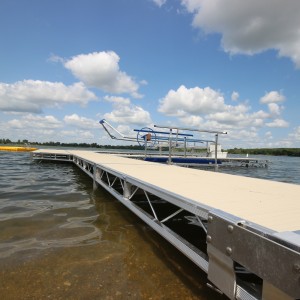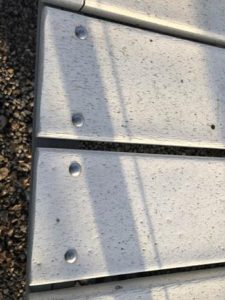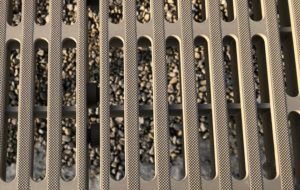DOES A DOCK NEED AN ANCHOR?
Do I REALLY need to use a dock anchor or auger? First-time dock owners in Door County ask this question all the time. Their concerns are valid – no one wants the extra work or cost if it isn’t needed.
First, let me say that on most inland lakes on the Door County peninsula it is not necessary to install an auger or anchor. Except for Lake Winnebago, the inland lakes generally are not deep enough or wide enough to be of concern. Without an open expanse, the waves typically do not present a problem. That statement is contingent on you having the dock set at the proper height.
WHAT SHOULD FIRST-TIME DOCK OWNERS LOOK FOR?
For new dock owners, we recommend you look around your area. How high are the docks set? Experience is a great teacher.
If a majority of the piers are set “low” to the water, it’s probably safe for you to do the same.

ShoreMaster TS9 dock
Here’s a great way to meet your neighbors. Most people want to help. Don’t be surprised if the name – Pier & Waterfront Solutions comes up in the conversation as the place to go.
In general, if the summer storms reach a height of 36 inches, then the bottom of the frame should be at least 38-42 inches above the water. This height allows the vast majority of the waves in a storm to pass under the dock frames.
WHO NEEDS TO ANCHOR A DOCK?
Summer thunderstorms kick up 4-6 waves on the bay of Green Bay with little warning. It’s no wonder that people use augers to anchor their docks.
One method to secure your dock is to pound pipe legs into the gravel or sand. This takes a toll on your back (or your friend’s back if you were smart enough to recruit help).
Not the best idea. Besides, you have to figure out a way to get the pipes out in the fall. You can’t pound UP!
This method is ineffective in most cases. A wave pounding against the bottom of the decking will lift the dock straight up. Once the leg is pulled out, the dock usually will twist or roll-over due to the continuous pounding from the waves.
WHAT OTHER OPTIONS DO I HAVE?
The recommended option is to use augers in critical locations. One way to do this: the husband holds the dock frame up (he’s strong you know). Meanwhile, his wife uses a pipe wrench to screw the auger pipes into the bottom. This is hardly a recipe for marital harmony either. We DO NOT recommend this procedure.
On a calm day, the only part of the pier that is in the water is the support pipes (legs). The legs have a low surface area in comparison to the entire dock. Waves easily pass around the legs with little resistance.
Minimal resistance is the key to securing your dock.
WHAT TYPE OF DECKING YOU USE IS IMPORTANT?
Most decking has an almost solid surface. As a result, there is no place for the water to relieve the pressure when it hits the dock. In a vast majority of decking, there are only a few 1/2″ openings in the decking. Waves hitting the underside of your dock have no way to reduce the pressure on the pier. This will cause an upward movement.
What’s the best decking with the least resistance to waves?
Flow Through decking provides the least resistance to the waves by reducing the surface area by 42%
Our advice is to assess the worst case scenario for wave conditions in your area. Then set your dock height higher based on those conditions.
Setting the dock height too low on the bay is a bad idea. You do so at your own risk.
Customers with steel framed docks and board decking have found their docks flipped over in storms. The dock usually sinks. or in some cases, get washed down the shoreline. The parts of some of these piers have never been located.
Others were damaged because they ran out of pipe length and did not want to replace the pipes with longer ones. With the higher water levels the past few years, pipes that are too short are getting common.
In some situations, even though the dock height is set correctly, a neighbors boat or other floating debris will hit your dock. You can’t prevent every situation.
WHAT ABOUT BEDROCK?
There are many places where dock augers do not work due to the limestone bedrock in Door County. There are three ways to handle this.
The first is to use angled leg pockets. The legs are angled out from the dock similar to spreading your legs to gain stability. This helps stabilize the dock more than standard vertical legs. However, this is no guarantee that the storms will not flip your dock. It does help though.
ANOTHER WAY
The second way to anchor a dock involves drilling in rock anchors. Once installed a chain is attached between the dock and the anchor. The problem is – how to locate the anchors after the ice goes out in Spring. In some cases, the ice and boulders that move in the Spring will destroy the anchors.
A final option involves using a large, heavy mass in the water to secure the dock. This serves as a dock anchor during a storm. Depending on the depth of the water this may have to be removed from the water each year. The ice may move it away if the dock anchor gets trapped in it. A submerged weight may not be the easiest way to secure a dock.
In summary, after everything is said and done, the simplest method is to keep the dock set higher than the waves.
Need Help Planning a Dock System For Your Home or Cottage?
Contact Pier & Waterfront Solutions TODAY!
Do you have a friend that may be interested in this information? Please share a link to this page with them.
PWS is located at 7325 St. Hwy 57. That’s 1 mile North of County MM (Hwy 42) and 3 miles South of Sturgeon Bay at the Idlewild Road intersection.
Our staff is here year-round to assist you.









